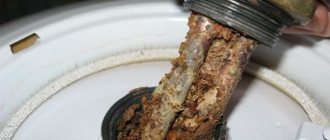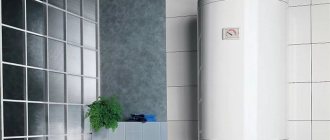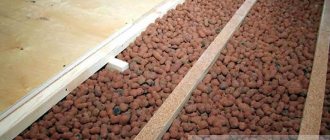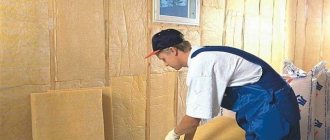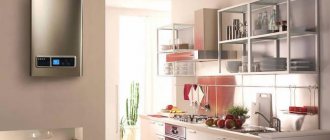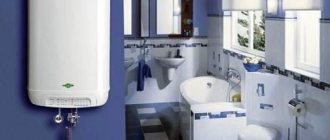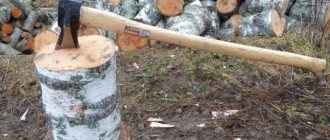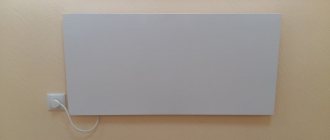The question of which heating elements are better is asked by users before choosing a reliable boiler. Models can be equipped with open or closed type heating elements, differing in materials of manufacture, principles of protection and heating. In this article we will talk about all the nuances of heating elements that you need to pay attention to when choosing models from Termex, Ariston and other brands.
Types of heating elements for water heaters
A heating element is a tubular electric heater made of a wire spiral. A metal shell is used to protect the element. By passing current through the material, the part intensively increases the temperature of the water
Technical features of heating elements
A “wet” heating element is always in the liquid and heats it. It is a hollow copper tube, inside of which magnesium oxide or special quartz sand is placed - these substances are characterized by high thermal conductivity. There is also a nichrome spiral inside the “wet” heating element. Their shape is typical: to understand what a “wet” heating element looks like, just look at the bottom of any electric kettle.
Copper “wet” heaters differ in parameters:
- can be flanged (cast or made by stamping) or nut;
- may or may not have an anode socket: if the heating element has a nut, there may not be an anode socket;
- They can be straight or elongated depending on the shape of the hot water tank.
A “dry” heating element does not come into contact with water - that is, the heating element in it is hidden in a steatite or silicate flask, and it is this that heats the water. Such water heaters can remain operational for a long time even with low water quality, because... scale will settle on the flask and not on the heating element. And you won’t have to clean such a heater. It is believed that the highest quality water heaters with flasks filled with oil are the most durable, reliable and consume less electricity than devices with heating elements whose flasks are filled with air. If there is sand in the flask, the water heater will also last a long time.
How to choose a heating element for a water heater
Before choosing a heating element for a boiler, it is necessary to take into account the type of flange, power, tubes for temperature control sensors, the presence of fasteners for the anode, as well as the material of the heating element itself. There are cases when it is not possible to select an original heating element. When choosing analogues, pay attention to, which has proven itself to be a reliable supplier of heating elements for boilers produced at the Italian plant of the largest manufacturer.
Flange Types
Pressing stamped flange type RF.
One of the most common among flanges.
Used in boilers with an internal stainless steel tank from Electrolux, Polaris, ATT, Garanterm, Thermex and others. This type of flange has the following diameters: 64, 72, 82 and 92mm. Pressure cast brass flange.
It is manufactured in diameters of 48 and 50 mm and is used in boilers with an enameled internal tank from Thermex, Ariston, and Atlantic companies. This flange has the following subtypes:
- RCA PA – there is an anode holder, characterized by bare elongated contacts and the absence of a plastic dielectric cover;
- RCF – there is an anode holder, the heating element has a bent shape, the contacts are insulated;
- RDF – there is an anode holder, a straight heating element, the contacts are insulated;
- RCF OR – there is an anode holder, the heating element has a bent shape, the contacts are insulated, made for horizontal models;
- RF – no anode holder, contacts are insulated, manufactured for Atlantic boilers.
Pressing flange made of stainless steel type RNSA oval.
Manufactured and used in Ariston water heaters.
Flange – threaded brass plug.
It is used in boilers from almost all manufacturers, as well as in homemade heaters. Has threaded pipe threads of various diameters.
Heating element power
The power is usually output from the tube of the heating element itself. Also, all the necessary information about power can be read in the product passport, as well as on the nameplate. If you cannot find a heating element with the same power as the original, then it is recommended to choose a heater with a lower power.
Heating element material
Heating elements made from various materials differ in quality and durability. Let's look at the three main and most common options:
- Stainless steel is one of the most budget-friendly and short-lived options;
- Copper - more powerful and reliable compared to stainless steel heating elements;
- Silver plated – resistant to scale, disinfects water, and has a long service life.
Thermostat tube
When replacing the original heating element, pay attention to the presence of the thermostat tube. If it is available on the old heating element, it is necessary that the new one also has it. If you find two tubes, then you can purchase a heater with one, because It is usually possible to install two sensors one after the other.
Additional products
When purchasing a heating element for a boiler, do not forget to buy a new gasket for it. If this is a heating element from the MasterProf company, then the gasket will already be included. It is also recommended to replace the anode - this will extend the service life of your boiler. Also, before purchasing, make sure that the thermostat and check valve are working; if they fail, they also need to be replaced.
Pros and cons of heating elements
To decide which type of water heater to prefer - with a “dry” or “wet” heating element, it is necessary to compare the pros and cons of both elements:
- The advantages of a “wet” heating element
are compatibility with any water heaters designed for this type of working element, quick heating of the liquid, low cost and a huge selection of devices. However, such water heaters will have to be cleaned frequently: a lot of scale settles on open heating elements, which also leads to unpleasant electric shocks when you touch the body. In addition, “wet” heating elements consume a lot of electricity for heating. - The advantages of a “dry” heating element
are the absence of strict requirements for water quality and the ability to maintain liquid temperatures up to +40°C. Such elements do not rust and remain operational for up to 15 years. But water heaters with closed heating elements are expensive, and the variety of such models is relatively small.
Water heating time and electricity consumption
The speed of water heating depends on what heating elements are in “Termex”, “Ariston”, “Electrolux” and other boilers. Of course, this is also affected by the volume of the tank, but the main indicator is the method of increasing the temperature:
- Open heating elements cope with this task faster, but at the same time consume quite a lot of energy resources.
- Closed heaters use less electricity but heat up more slowly. As a result, utility costs become approximately the same.
Location of the dry heating element in the water heater
So, which heating elements are the best is quite difficult to decide. When choosing, you should proceed from your goals. To do this, you need to know the volume of the tank and the expected number of users, and other operating conditions.
You can learn more about the features of closed and open heating elements of electric water heaters at. Contact us, we will help you decide on the best option!
Service life and replacement nuances
If the network voltage is stable, a closed heating element from a premium manufacturer will withstand 20 years of operation. For wet heaters, this figure is much more modest - 4-5 years.
As it operates, the resource of any heating element is depleted, so you can’t count on the eternal service of either a “dry” or “wet” device. However, replacing a closed heating element is simpler and accessible to a non-professional. To remove it from the tank, you just need to unscrew the heating element from the flange, and you won’t have to drain the water.
Replacing an exposed heater will take time and will look something like this:
- The water heater is turned off and water pours out of it;
- The heating element is disconnected from the network;
- The lid is removed from the tank;
- The voltage at the terminals is measured;
- The current-carrying wires are removed to the side;
- The contacts of the new heating element are wiped dry.
Installation of a new “wet” heating element is performed in the reverse order. It is important to use seals that are free of defects and of the highest quality. Upon completion of the repair, the water heater is filled with water and plugged into the outlet.
It is impossible to say with certainty which heating element is better - “dry” or “wet”. If the low price and speed of heating water are important, you should choose a “wet” heating element; if durability and ease of replacement are a priority, a “dry” heating element is preferable.
Which heating elements are better - the main selection criteria
To determine which heating elements will best cope with the assigned tasks, you need to take into account the purpose of the facility where the water heater will be installed. Many other factors are also taken into account, including:
- Estimated number of users.
- Volume of the tank.
- Allowable heating rate.
- Economical energy consumption.
When choosing heating elements for widespread use, the main indicator that users pay attention to is power. By studying reviews from equipment owners and consulting with experts, you can choose reliable and durable models. Among inexpensive and high-quality manufacturers, Termex heating elements are very popular.
Various options for heating element shape configurations
Best models: top 9
Boiler models with dry heating elements are always popular due to their reliability and safety in operation. To choose a boiler for yourself, you need to take into account its cost and size - the water heater must fit well into the room where it will be installed. Many boilers have the ability to install them on the floor or hang them on the wall using special fasteners. The location can be different: horizontal or vertical. The stainless steel tank of such brands as Atlantica, Termex and Zanussi is their advantage, as it extends the life of the devices.
This rating was compiled based on recommendations from consumers who bought boilers from these brands and have been using them for a long time. They assessed the functionality of this water heating equipment and learned their advantages/disadvantages.
Boiler Fagor CB ECO
- Price - from 12,300 rubles.
- Volume – 150 l.
- Country of origin : Spain.
- White color
- Weight – 43 kg.
This European manufacturer opens the rating of dry water heaters, providing its products with the appropriate certificates in accordance with international standards. According to customer reviews, this boiler is reliable for a large family. The price is affordable to purchase it for almost any home.
Fagor CB ECO water heater
| pros | Minuses |
| Design | Poor mounting anchors |
| Heats up quickly | |
| Maintains temperature for a long time |
Gorenje OGBS100SMV9
- Price - from 10,100 rubles.
- Volume – 100 l.
- Country of origin : Serbia.
- White color
- Management is electronic.
- Weight – 41 kg.
The Gorenje electric heater is reliable and high-quality equipment that will last for many years. A convenient interface allows you to set the desired heating temperature. Added functions: power indicator, heating temperature limitation, 4 degrees of protection - allows you to feel the convenience of having such equipment in your home.
Gorenje OGBS100SMV9 water heater
| pros | Minuses |
| Heats water very quickly up to 70 degrees | Not very clear controls |
| Compact | |
| Good quality |
Atlantic Vertigo
- Price - from 17,200 rubles.
- Volume – 80 l.
- Country of origin : France.
- White color
- Management is electronic.
- Weight – 33 kg.
- Dimensions (WxHxD) – 49x109x31 cm.
Soapstone heating elements are a development of the Atlantic brand. French developers were looking for ways to improve the performance of the equipment, and the invention of such a heating element allows this water heater to be used for a long time.
Atlantic Vertigo water heater
| pros | Minuses |
| Good quality, design | Bad anchors |
| Heats up quickly | |
| Convenient control |
Electrolux EWH 50 Formax DL
- Price - from 10,799 rubles.
- Volume – 50 l.
- Country of origin : China.
- White color
- Management is electronic.
- Weight – 23.1 kg.
- Dimensions (WxHxD) – 34.4×82.5×35 cm.
Electrolux electric heaters are quite compact, quickly heat water, saving time and electricity.
Electrolux EWH 50 Formax DL water heater
| pros | Minuses |
| The flat shape of the Electrolux boiler saves space and looks good | No fasteners included |
| Good thermal insulation, loses less than 10 degrees of heat in 12 hours when turned off | |
| 3 heating modes |
Willer Elegance IVB DR
- Price - from 11,345 rubles.
- Volume – 80 l.
- Country of origin : China.
- White color
- Control is mechanical.
- Weight – 18 kg.
- Dimensions (WxHxD) – 49.3×99.2×29 cm.
A special feature of this unit is a fundamentally new tubular heating element system, which allows for rapid heating of water. A protective magnesium anode ensures the safety of the tank from corrosion and extends its service life. A good device for little money.
Willer Elegance IVB DR water heater
| pros | Minuses |
| The controls are very clear | There is no sound signal about the end of heating |
| Heats water in a few minutes | |
| Tank cover: stainless steel |
Atlantic Steatite Cube VM 75 S4 CM
- Price - from 13,990 rubles.
- Volume – 75 l.
- Country of origin : France.
- White color
- Control is mechanical.
- Weight – 27 kg.
- Dimensions (WxHxD) – 49×70.6×52.9 cm.
The French are very responsible in the production of various equipment and this water heater is no exception. European quality, reliability, stable operation of the boiler will please any buyer.
Atlantic Steatite Cube VM 75 S4 CM water heater
| pros | Minuses |
| Two operating modes (1.2 and 2.4 kW) | No built-in thermometer |
| Good thermal insulation | |
| Heats up quickly |
Ariston PRO ECO 50 V DRY HE
- Price - from 13,990 rubles.
- Volume – 50 l.
- Country of origin : Italy.
- White color
- Management is electronic.
- Weight – 16 kg.
- Dimensions (WxHxD) – 45×52.8×47 cm.
Another European representative of reliability and compactness is the Ariston brand water heater.
Ariston PRO ECO 50 V DRY HE water heater
| pros | Minuses |
| Compact, lightweight, performs its functions well | Water cools quickly |
| Has accelerated heating | |
| There is an RCD |
Gorenje GBFU 80 E B6
- Price - from 10,711 rubles.
- Volume – 80 l.
- Country of origin : Serbia.
- White color
- Control is mechanical.
- Weight – 30 kg.
- Dimensions (WxHxD) – 45.4×81.6×46.1 cm.
Gorenje GBFU 80 E B6 water heater
| pros | Minuses |
| Horizontal installation | High power consumption |
| Convenient control mode | |
| Price quality |
Marking of heating elements: decoding
In order to be able to distinguish some heating elements from others, special markings were developed, fixed by the state standard.
It is applied to the surface using a press and should be located close to the insulator.
Consider, for example, the following marking:
100А13/1.6р220 - 2R30
- The number 100 indicates the unfolded length of the heating element in centimeters.
- The letter “A” in the marking encodes the depth of embedding of the contact rod (I will give the decoding below).
- The number 13 indicates the diameter of the tube in millimeters.
- The number 1.6 indicates the heater power in kW.
- The letter “p” encodes the heated medium (in this case, water and weak solutions of alkalis or acids) and the tube material (carbon steel).
- The number 220 indicates the supply voltage is 220 V.
- Number 2 is the number of the heating element shape (in this case it is U-shaped).
- R30 is the bending radius of the heating element in millimeters.
Now let's decipher the length of the contact rods. Look at the picture below:
Designation of heating elements markings
Now let's move on to the second letter in the marking.
Here is a breakdown of the most popular options:
| Letter | Heated medium | Tube material | Maximum specific power, W/cm2 |
| X | Water or weak solutions of alkalis and acids | Copper or brass | 9 |
| P | Water or weak solutions of alkalis and acids | Carbon steel | 15 |
| J | Water or weak solutions of alkalis and acids | Stainless steel | 15 |
| Z | Fats or oils | Carbon steel | 3 |
| O | Air or other gas mixtures (with blowing) | Carbon steel | 5 |
| S | Air or other gas mixtures (without blowing) | Carbon steel | 2,2 |
Everything is deciphered in more detail in GOST 13268-88.
For air heating elements, the presence or absence of airflow and even the required air speed are specified.
If you use heating elements designed for blowing in calm air, they will quickly burn out due to too high power density.
To complete the review, I will add a picture with the forms. This will help you navigate them more easily:
Types of heating elements
Exploitation
Infrared heater: manufacturers and types
Heating elements most often break down precisely due to improper use of water heating devices. Due to any malfunctions in operation, the following problems with the heating part are possible:
- metal bursts due to prolonged exposure to high temperature or stress;
- the shell loses its initial seal, which leads to immediate breakdown of the heating element;
- rust particles and signs of structural destruction appear due to improper handling of the heating device;
- failure due to long-term violation of safety and maintenance rules.
The list of possible problems is not limited to the above list. In general, each violation leads to one or another unique breakdown. For example, even in the case of an incorrect attitude to the volume of liquid, the heating element can fail (if the tank has a volume of 80 liters, the space must be filled so that the heating element is completely immersed in water).
Types of heating elements for an 80-liter boiler
